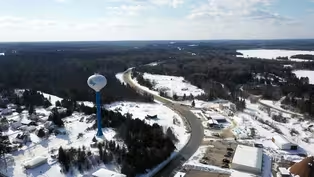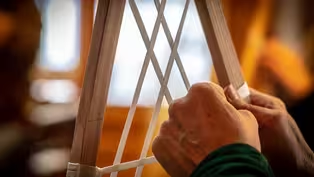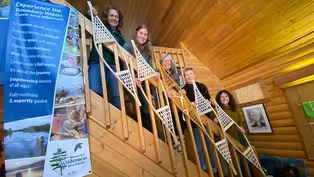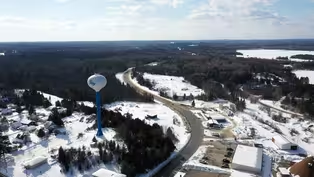Prairie Sportsman
Trekking the Wilderness
Season 13 Episode 6 | 27m 46sVideo has Closed Captions
Peta Barrett guides wilderness trips year-round and teaches Ojibwe-style snowshoe lacing.
Peta Barrett sold her Minneapolis talent agency and founded Women's Wilderness Discovery to guide Boundary Waters and Superior National Forest trips year-round. She also leads workshops on camping skills and lacing Ojibwe-style snowshoes.
Problems playing video? | Closed Captioning Feedback
Problems playing video? | Closed Captioning Feedback
Prairie Sportsman is a local public television program presented by Pioneer PBS
Production sponsorship is provided by funding from the Environment and Natural Resources Trust Fund, West Central Initiative, Shalom Hill Farm, and members of Pioneer PBS.
Prairie Sportsman
Trekking the Wilderness
Season 13 Episode 6 | 27m 46sVideo has Closed Captions
Peta Barrett sold her Minneapolis talent agency and founded Women's Wilderness Discovery to guide Boundary Waters and Superior National Forest trips year-round. She also leads workshops on camping skills and lacing Ojibwe-style snowshoes.
Problems playing video? | Closed Captioning Feedback
How to Watch Prairie Sportsman
Prairie Sportsman is available to stream on pbs.org and the free PBS App, available on iPhone, Apple TV, Android TV, Android smartphones, Amazon Fire TV, Amazon Fire Tablet, Roku, Samsung Smart TV, and Vizio.
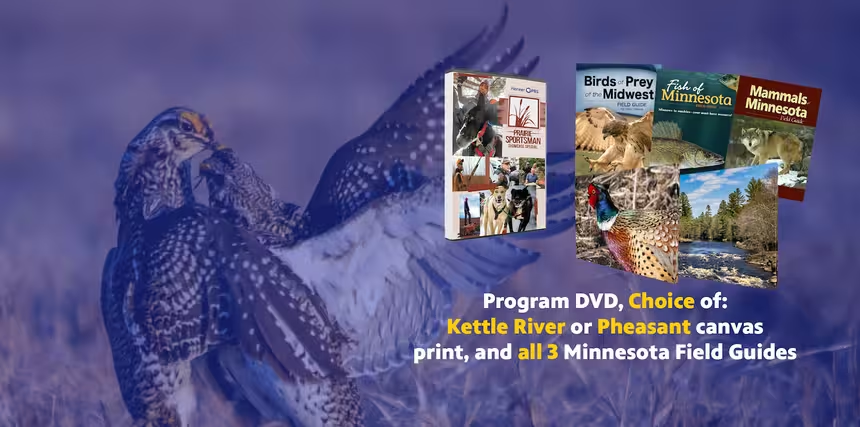
Prairie Sportsman Premium Gifts
Do you love the great outdoors, hunting, fishing, hiking and conservation? Consider becoming a friend of Prairie Sportsman to support the show and receive gifts with your contribution.Providing Support for PBS.org
Learn Moreabout PBS online sponsorship(gentle tones) - So she had all these skills and I'm like oh my gosh, Sandy, I want to learn wilderness travel.
'Cause you know, I've been a car camper all my life.
What's this all about?
I mean, from that first trip on, the bug bit.
- I'm actually not someone who comes to the community with a ton of backwoods experience.
I'm not a paddler, as I like to jokingly say, but she does obviously have such a teacher's background that she's made it really accessible.
(exciting music) - [Announcer] Funding for this program was provided by The Minnesota Environment and Natural Resources Trust Fund, SafeBasements of Minnesota, your basement waterproofing and foundation repair specialists since 1990.
Peace of mind is a safe basement.
Live Wide Open, the more people know about West Central Minnesota, the more reasons they have to live here.
More at livewideopen.com.
Western Minnesota Prairie Waters, where peace, relaxation and opportunities await.
(gentle music) - Being out away from technology in the dark, having to use a headlamp, having to use an outdoor latrine, I know these things all sound so silly, but it can be really frightening for women who have never done anything like that.
I mean, I've taken women out who have never seen a sky full of stars because they've never been out of the city.
(gentle music) (exciting music) - [Bret] Peta Barrett founded Women's Wilderness Discovery in 2014 to guide people into the wild outdoors.
While she leads both males and females on Boundary Waters and Superior National Forest trips, she specializes in guiding women who are new to wilderness adventures.
- I lucked out in forming this company just at the right time, when women's adventure travel was becoming something, and it's still an underserved market.
I started Women's Wilderness Discovery with the goal of offering a place where women specifically can come, feel comfortable asking questions, know that they're gonna be provided the lightest gear.
They're gonna have a female wilderness professional guide them.
We provide all the gear, and just to build self-confidence and courage and self-esteem.
- [Woman] I think that's easy enough.
- [Woman] Sure.
- [Bret] Peta holds a secondary education degree in theater arts and uses her teaching skills to help women overcome their fears.
- Just the physicality of it.
I don't think I can, I've never paddled a canoe.
I've never, I don't know if I can carry a pack.
What are the parameters?
And so I give my women some things to do to prep.
You know, if you're a city walker and you've been on paved trails the whole time, get off that paved trail.
Take uneven ground.
Take a little backpack, throw some books in there, add some cans or rocks.
If you get up to 30 pounds and you're walking on uneven ground, you're gonna be fine.
(gentle music) - [Bret] Growing up in a family that loves to hunt, fish and camp, Peta has been well connected to the outdoors since childhood.
But when she reached the age of 30, she was ready for more challenging adventures, and that's when Peta met Sandy Dodson.
- So she had all these skills and I'm like oh my gosh, Sandy, I want to learn wilderness travel.
'Cause you know, I've been a car camper all my life.
What's this all about?
And so she put together a trip with some other ladies who it was their first time, and from that first trip on, the bug bit.
- [Bret] She went on a few more excursions with her friend and learned how to navigate with a map and compass.
- Finally, my friend Sandy said you know how to do this.
You can do this yourself.
So I started taking out friends and collecting gear, and it evolved into I just love taking friends out every summer.
(upbeat music) - Another day on the trail.
- [Bret] For 25 years, Peta and a group of female friends have made an annual trek to the Boundary Waters.
- She taught us how to make pizza in the Boundary Waters, and so that is like a staple every year when we go now.
Peta is somebody who knows how much food the moose eat every day.
She knows the flora that you're walking by.
She knows the good blueberries from the fake blueberries.
She knows the poison ivy.
She is quite a role model when it comes to outdoor expertise and fun and adventure.
She's got the whole package.
- [Bret] When she started her wilderness adventures, Peta worked as a costume designer, then became an on-camera and voiceover artist before assuming ownership of a friend's talent agency called NUTS.
But she continued to lead five or six wilderness trips a year with friends and family.
- And I thought, but I really like doing this.
(gentle music) When I was ready to get out of the talent industry, I started testing those waters by offering an auction trip where I'm gonna take out strangers.
And I thought, am I gonna like taking strangers out?
Well, I loved it.
- [Bret] One of the auction winners was a couple in their 50s who were not in great physical shape, and they brought along their two sons and a teenage grandson.
Peta set out to introduce them to the wilderness.
- And here they'd see me, this short little woman.
I was probably 53 at the time.
I'm 63 now.
And they'd see me hustling down the trail with a pack on my back and whip that canoe up and go, and inch by inch, they just started adapting and pushing themselves a little bit more.
But by the end of this trip, it was amazing, the growth that had just happened.
On the very last big long portage out, I turned around, I put the canoe down in the water and I turned around, and here's that teenage boy and his dad right there on my heels carrying both a pack and a canoe, and they were just like, this was so, and they were high fiving me and I'm like, you are doing an awesome job.
The kid was gonna be starting football practice in two weeks, and I said, you are gonna be so ready for that.
They sent me the nicest card later, like two, three, four weeks later, and they said, you're our inspiration.
Doing this trip and getting us out there, seeing what can we can do.
We have the picture, the group picture was me and them, and we've got you on our fridge.
My husband quit smoking, we're eating better.
I was like, holy mackerel.
I'm just taking these people out to experience the wilderness, and they were the first ones who said this was really a life changing experience, and we appreciate it.
Thank you.
(gentle music) - [Bret] Peta moved to Ely with her husband Dean, who was retired, and sought out help from her friend Dan Cook on how to start a wilderness business.
- Danny said well, be careful, Peta.
If you're starting to guide in the wilderness and take money for doing that, there are rules and regulations and you have to get permitted for it.
- [Bret] She earned CPR and Wilderness First Aid certifications, and successfully applied for a US Forest Service permit to lead groups of up to nine people.
She offers two types of guided services, scheduled trips that anyone can sign up for on the Women's Wilderness Discovery website, and customized trips for organizations, families, and friends groups.
Peta contracts with eight or nine female guides ranging in age from 23 to 70, who lead 25 to 30 trips in the summer and about two per month in the winter.
- [Peta] Most of the outfitters are shuttered for the winter, but I'm one of the very few here that stay open year round.
So I do summer canoe camping and I do winter hot tent trekking.
It's more work to winter camp.
You burn more energy and there's a lot more setup and you're processing a lot of wood to keep that wood stove going when you need it hot in the tent.
- [Bret] Winter wilderness guides bring along one or two hot tents depending on their group size, but they prefer sleeping outdoors.
- And if you've never done that, winter is amazing for a number of reasons, but I mean, the sky is so crystal clear, the stars are thick and you don't have bugs, no bugs.
(upbeat music) I was happy in the other careers in life and that was great, but could I keep up that kind of rat race?
Not a chance.
Like I said, I like living in a two stoplight town and I don't have to cross railroad tracks to go to work.
I just have to make sure the four wheel drive is working and the Forest Service has grated the road.
I'm a people person, and everything I've done in my life, it's people, people, but what really recharges my batteries is to be away and be quiet and be in that wilderness.
When I can do something like guide a group, and yeah, you've got, it's hard work, but I enjoy that hard work, that physicality of it.
When somebody's just discovered some glorious thing in the outdoors, I say it is the best office in the world.
- Fills my soul, honestly.
It grounds me and it reminds me I don't have to go very far to feel like I'm in paradise.
(soft music) - Because up here, a fine pair of modern snow shoes, tubs or whatever the brands with the aluminum teeth.
They're great, but they're only great on pack trails, but these traditional ones really work best up here, and they work best in this Boundary Waters wilderness area.
- The Ely area's history dates back centuries when the Bois Forte band of Ojibwe traveled here from the East Coast.
In the 1700s, French fur traders arrived, and in the late 1800s, prospectors came in search of gold, but instead found iron ore. (exciting music) Women's Wilderness Discovery in Ely offers guided Boundary Waters and Superior National Forest trips year round.
Founder and Owner Peta Barrett also leads workshops on outdoor skills and lacing Ojibwe-style snowshoes.
In January, we visited Peta at her facility, where she was teaching three women to lace snowshoes who had never done it before.
(exciting music) Because lacing a snowshoe can take many hours, the group started the evening before we arrived.
Peta demonstrated for us the first steps that she leads her students through when the workshop begins.
So when it comes to making snowshoes, how much work is involved with it and what do you start with?
- Well I like to start with a Minnesota made kit from Country Ways Snowshoes.
So everything you see here comes from a company down in the cities.
White ash frames are already made.
Some people think oh, I'm gonna take a snowshoe lacing class, and I specifically say a lacing class, because we're not steaming and bending.
No, that's a different level.
So a lot of people just want to get right to it, so I buy the kits that.
- That's good, because mine would just be a two by four that I duct taped to my shoe.
- There is some artistry to bending, harvesting your own wood and bending it and everything.
So we start with this white ash frame.
The kit comes with nicely sanded two snowshoes, the bundles of lacing that we need to cut ourselves into the right lengths.
The first thing that we do before we can work on these snowshoes is we start marking stations.
So the stations, here I have a finished snowshoe.
The stations are these girth hitches that go around the outer frame, and on a medium pair, you're gonna do about 42 girth hitches.
What we do to begin is we follow the directions on how to place this little guide to mark in stations and we center it.
We're gonna mark the tail first.
Then we go mark the toes, and the center section is what we do the very last, because that really requires your best lacing technique now and the right tension.
We mark the stations starting with the tail first of all, and it's just a light pencil mark.
We go on down, marking the stations like this.
So now we've just marked the stations.
There are one, two, three, four, five, six, seven, eight stations.
In the tail of a large, they're gonna be eight stations up here.
It's the same lacing pattern.
(soft music) (snowshoes crunching) - [Bret] Why did you decide to make snowshoes part of what you do here?
- One of my favorite seasons, and I'm a born and raised Minnesotan, is winter.
I love winter.
And part of what I was doing early on before I ever started this business was that I was taking youth out on winter fire and ice trips we'd call them, up to Wilderness Canoe base and build twinsies and do the sauna in the dark and jump in the lake and all these wonderful things.
And so we really would take the kids out, doing a lot of snowshoeing.
Back in my hometown of Elk River, we all started to learn to lace snowshoes.
The bug bit, and I was like gosh, this is fun.
And a lot more people wanted to learn it.
And so I took on that little joyful task of teaching people how to lace their snowshoes.
The Ojibwe-style snowshoe is, people ask why do you use this one?
I mean, there are Alaskans, there are Michigans, the round toed, all these different styles, which were all ultimately a native design.
The lakes and woods people that were the Ojibwe and are the Ojibwe, they designed this style because this pointed toe parts the brush as you're going through the woods, and this gives you enough square inch area of support that it's great out on the open lakes too, because up here, a fine pair of modern snowshoes, tubs or whatever the brands with the aluminum teeth, they're great, but they're only great on pack trails.
But these traditional ones really work best up here, and they work best in this Boundary Waters wilderness area, because it is a combination of you might be portaging through the woods or just bushwhacking through the woods to go get a wood supply.
And if you've got four or five feet of snow, just going out there in your mukluks or your boots doesn't work.
And the natives would've done it in leather or bubish.
We use a modern tubular nylon lacing that could withstand 1,400 pounds of stress per strand.
It really floats you.
There's something about this weave that floats you on the deep snow out on the lakes.
So to begin, every toe tail or center starts with a slip knot, and I start running towards the tail.
I bring it over, loop it around and through.
That is the basic, that's the basic slip knot, no matter where you're putting it.
And so then I start tightening that down.
It's a slip knot.
I know that I have to go to station two, station three, station four is down here.
I don't have people mark stations on the brace, 'cause these are movable.
So we go over the frame, we pull this running end.
This is the business end.
And we pull that through all the way.
You get good at flipping lacing.
I'm gonna send this under, first one went over, trap it.
This second part of the girth hitch goes under, over and through.
- [Bret] Peta stopped to check on her students, who with the help of her long time friend Janet Meier, are learning that snowshoe lacing skills require more math than artistry.
- I'm very much like, let's go right now, take it step by step, and this is not exactly a process you should take step by step.
You do have to do a little bit of fore planning.
- Before you get too far, you need to check here, 'cause I don't think that's right.
If she just goes up there and comes down here, this isn't right.
- You want me to check further?
Okay.
But anyway, so 22, we would go to 23.
- She might actually be at 18 and 19.
- Yeah, exactly.
- See how this is, these aren't crossed?
- Yeah.
We restarted a couple of times, just 'cause it kept getting buggered up.
So it's been a learning process.
Even when I thought I had it, I didn't quite have it.
So you know, that's life.
You gotta retry things, redo things.
You get better with each try.
- I was very nervous coming into the experience, and I thought oh my gosh, okay.
Well, if it's awful, if they look terrible, then I'll just hang them on the wall and they'll be decor and it'll be like cool, we live in Ely, here's snowshoe art.
I'm actually not someone who comes to the community with a ton of backwoods experience.
I'm not a paddler, as I like to jokingly say, but she does obviously have such a teacher's background that she's made it really accessible.
It's been really fun, and I think I'm gonna have a functional pair of snowshoes at the end.
- This shoe is one that I did for a previous class, and it is ready to dip, because what we've done is all the sections have been laced.
This is the center section, the most important for tension, and it's the last section we do.
So when this center section is in its raw stage, these uprights and this master cord are not yet wrapped, and you see all of this lacing, it is wrapped, and just feel that, Bret.
Feel how solid.
It's almost like a piece of wood.
(upbeat music) - [Bret] The shoes will be dipped three times in an oil-based outdoor urethane.
After they're dry, Peta recommends hanging the shoes crisscross on the wall when not in use to prevent warping.
Besides Women's Wilderness Discovery, Peta's taught snowshoe lacing at folk schools in Marine on Saint Croix and Ely, where she teaches other outdoor skills.
- I love to offer workshops on map and compass navigation, quick release knots for the trail, looking for and harvesting good, dry, dead, down firewood, and how to build a campfire or how to stoke a woodstock.
Sometimes it's fun to tie in something like hey, we're gonna learn these skills.
Now we're gonna go out and do just one night on trail, we'll come back here, we're gonna have a morning yoga and serve up a little brunch and then you go home.
(exciting music) - I'm gaining independence and confidence, even just by being exposed to people like Peta, not even going on a trip yet.
She's taught me this skill, which is just kind of opening my eyes of oh, what else could I make?
And oh, how can I use these in the wilderness?
I've just loved spending time out in the wilderness because it grounds me and it centers me and I get inspiration and I feel so good at the end of the day having worked from, canoed from one lake to the next, to the next, and portaged and got from one campsite to the next and set up tent and cooked and built a fire.
And it's just like oh, these are really important skills that we don't get to use every day, and it's just empowering to know that I can take care of myself and I can survive in the wilderness with myself, with others.
If there was ever an apocalypse, I'd survive.
(exciting music) - [Bret] Ely, Minnesota is a destination for those drawn to wilderness adventures.
Located in the Superior National Forest, Ely is the gateway to the Boundary Waters canoe area wilderness, which offers pristine escapes year round to paddle, snowshoe, camp and fish.
(exciting music) Ely is the self-proclaimed sled dog capital of America.
From recreating to racing, sled dogs are part of Northern Minnesota's culture.
The annual WolfTrack Classic Sled Dog Race was established in 2008 by the Ely Chamber of Commerce to provide a winter counterpart to Ely's popular Blueberry Art Festival held in July.
The sled dog race spans 65 miles through Northern Minnesota state trails and involves hundreds of sled dogs and mushers from the upper Midwest and Canada.
One of the racers, Ryan Miller, owns Underdog Sled Dog Company in Ely.
He introduces friends and family to winter wilderness camping using sled dogs to carry supplies.
- It's a lot of work just driving these dogs, breaking through slush, breaking trail, drilling holes, getting water, collecting firewood, splitting wood, chopping meat for the dogs.
It's all work, but man, when you get 12, 15 miles out into the Boundary Waters and sunset and you get to watch the sunrise the next day, sometimes the Northern lights are out.
Wolves will haul back and forth with the dogs sometimes.
You can't beat that.
That's about one of the best experiences you can have, in my opinion.
- [Bret] Ryan also works for the US Forest Service that employs sled dogs to carry in supplies like wood for replacing portage boardwalks.
The Ely area's history dates back centuries when the Bois Forte band of Ojibwe traveled here from the East Coast.
In the 1700s, French fur traders arrived, and in the late 1800s, prospectors came in search of gold, but instead found iron ore. Mining operations were open and brought settlers and other industries like logging.
Railroads were laid between Tower and Florence, which was later renamed Ely after a mining executive.
While the demand for iron ore surged during the world wars, it dropped off in the 1960s and 70s, and many mines and logging operations closed.
In 1964, congress passed a Wilderness Act that made the BWCA part of the National Wilderness Preservation System, and mining and logging were replaced by a thriving outdoor industry.
Ely's history and folklore is celebrated in several local museums, and its natural history comes to life at the North American Bear Center and at the International Wolf Center founded by world renowned researcher Dave Mech, who started studying wolves in the late 1950s.
- At that time, 1958, wolves were considered vermin generally, and that is they were not protected anywhere in the US or Canada for that matter.
Actually, probably they weren't really protected anywhere in the world, except for national parks or something.
- [Bret] Dave studied wolves at Isle Royale and spent 25 summers near the North Pole, where he pitched a tent near a wolves den and studied their behavior.
The white wolves on Ellesmere Island were tame because they'd never been hunted or trapped.
Dr. Mech wanted the world to better understand wolves, so he led efforts to open the nonprofit International Wolf Center in 1993 that draws more than 40,000 visitors annually.
One of the center's most popular exhibits, Discover Wolves, helps people get past their fears to view wolves from the eyes of researchers.
- You can watch a video that was actually taken inside of a wolf den in Voyageurs National Park.
So you can see wolf pup development.
You can also learn about how far wolves travel.
They're amazing dispersers.
- [Bret] Beyond its museum and outfitters, Ely also has a vibrant downtown, with shops and restaurants and the unique Brainstorm Bakery.
In 2007, when owners Brian and Andrea Strom started selling Crapola, their unique cranberry-apple flavored granola, they caught the attention of Jay Leno.
- Okay, one last one.
Now this is a combination of cranberry, apple and granola.
It's a drink, it's a drink.
This is why you hire people coming up with a professional name.
Now locally made Crapola.
(audience laughing) - [Bret] The homemade granola that started as a joke and was only sold locally hit the national stage.
- We got this plug by Jay Leno, but it was too much too soon.
We didn't even have a website.
- We had nothing.
I never thought we'd be here now.
In the early days, it just kind of seemed like a funny on the side thing we would do locally.
I had no idea we'd blossom into a real full-time business.
- So it started as the joke, and then from there we had no plan to do anything else.
There was no plan to launch a second flavor, but when it came to that time, we said well, what should we call our second flavor?
And then naturally Number Two seemed like the perfect name.
- [Bret] The Stroms added more flavors, like Colon-ial Times and Kissypoo, and their high fiber granolas are now sold nationwide.
Whether indoors or out, the people of Ely just want to have fun.
What better place to escape traffic and high pressure jobs than at the edge of the wilderness?
(gentle music) - [Announcer] Funding for this program was provided by the Minnesota Environment and Natural Resources Trust Fund, SafeBasements of Minnesota, your basement waterproofing and foundation repair specialist since 1990.
Peace of mind is a safe basement.
Live Wide Open, the more people know about West Central Minnesota, the more reasons they have to live here.
More at livewideopen.com.
Western Minnesota Prairie Waters, where peace, relaxation and opportunities await.
- I do.
No, it's Moscado.
It's an Italian wine.
It's very good.
Are you on?
- [Cameraman] I'm on.
- Here's to 11 years!
(group cheering) - [Cameraman] This is action, you're on.
- Wave.
Here we go, 10 years for these old babes.
11, 11!
Video has Closed Captions
Clip: S13 Ep6 | 6m 2s | Ely, Minnesota is the gateway to the Boundary Waters Canoe Area Wilderness. (6m 2s)
Video has Closed Captions
Clip: S13 Ep6 | 10m 39s | Peta Barrett leads workshops on lacing Ojibwe-style snowshoes. (10m 39s)
Video has Closed Captions
Clip: S13 Ep6 | 9m 14s | Women's Wilderness Discovery in Ely leads Boundary Waters trips year-round. (9m 14s)
Preview: S13 Ep6 | 30s | Peta Barrett guides wilderness trips year-round and teaches Ojibwe-style snowshoe lacing. (30s)
Providing Support for PBS.org
Learn Moreabout PBS online sponsorshipSupport for PBS provided by:
Prairie Sportsman is a local public television program presented by Pioneer PBS
Production sponsorship is provided by funding from the Environment and Natural Resources Trust Fund, West Central Initiative, Shalom Hill Farm, and members of Pioneer PBS.


